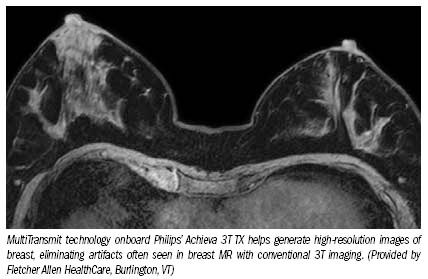Philips' novel MR technology overcomes 3T's body pitfalls
Neurological and musculoskeletal imaging are spectacular at 3T, thanks to its higher signal to noise ratio compared with lower field strengths.
Neurological and musculoskeletal imaging are spectacular at 3T, thanks to its higher signal to noise ratio compared with lower field strengths. Radiologists have long wished the same were true in the rest of the body, where dielectric shading can obscure signs of disease, as in the case of breast and liver cancers. Further limiting the clinical use of 3T has been the potential for excessive tissue heating as measured by 3T's specific absorption rate.
In October last year Philips Healthcare began shipping what company executives say is the solution to both problems: the Achieva 3.0T TX. The 3T scanner's MultiTransmit parallel RF, which execs say is compatible as an upgrade with 95% of Philips' installed 3T systems, adjusts multiple radiofrequency transmissions to the unique shape of each patient. This tailoring cancels out most or all of the dielectric shading artifacts that might otherwise occur and reduces the amount of energy deposited in the patient during the scan, they say.
Dr. Steven Braff, who was among the first to read MultiTransmit images, says the Achieva 3.0T TX operating at Fletcher Allen HealthCare in Burlington, VT, sharply decreases dielectric shading commonly seen in abdominal imaging done with conventional 3T equipment.
“We have dramatic examples of liver scans that would have been nondiagnostic 90% of the time (on a conventional 3T scanner) but were very diagnostic on the TX,” said Braff, chair of radiology at the University of Vermont.
Breast scans illustrate the resolving power of Philips' MultiTransmit technology. Technologists once spent 15 minutes manually shimming conventional breast MR scans at 3T to reduce dielectric shading, Braff said.
“A breast exam could take up to an hour (on conventional 3T) versus now doing them in 30 minutes routinely with the TX system,” he said.

In terms of staff time, the only cost to using MultiTransmit technology is a one-minute preparatory scan, which provides information for adapting sequences to individual patients. This not only cuts the artifacts that threaten to render 3T useless in certain parts of the body, but minimizes the RF energy deposited in patients. Reduced tissue heating cuts the amount of downtime between scans, speeding exams and increasing productivity. Braff estimates that MultiTransmit parallel RF can cut exam times by up to 40%.
“In the abdomen, we are able to do single-shot fast spin-echoes in 55 seconds versus about a minute 40 seconds without TX,” Braff said. “Spines that might take us six and a half minutes for a stack of T1 fast spin-echoes take us less than four minutes on the TX.”
Minimizing scan time is particularly important when doing pediatric abdominal exams, which Braff and colleagues routinely use to rule out appendicitis, avoiding the radiation risks of CT.
In their initial experience with the Achieva 3T TX, the University of Vermont staff picked up every instance when a child needed surgical intervention, a finding Braff plans to submit for peer-review publication.
Faster scans have the side benefit of reducing patient retakes, even eliminating the need for anesthesia among pediatric patients. This further improves productivity.
Still a year or two away, according to Braff, are routine cardiac scans with the Achieva 3T TX. The technology is up to the task right now, he said, but the sequences have to be optimized. Toward that end, the University of Vermont team has begun using the Achieva 3T TX to examine pediatric patients with congenital heart disease, tweaking the protocol to get diagnostic scans of the heart, as well as the coronaries.
GE HealthCare Debuts AI-Powered Cardiac CT Device at ACC Conference
April 1st 2025Featuring enhanced low-dose image quality with motion-free images, the Revolution Vibe CT system reportedly facilitates improved diagnostic clarity for patients with conditions ranging from in-stent restenosis to atrial fibrillation.
The Reading Room Podcast: Current Perspectives on the Updated Appropriate Use Criteria for Brain PET
March 18th 2025In a new podcast, Satoshi Minoshima, M.D., Ph.D., and James Williams, Ph.D., share their insights on the recently updated appropriate use criteria for amyloid PET and tau PET in patients with mild cognitive impairment.